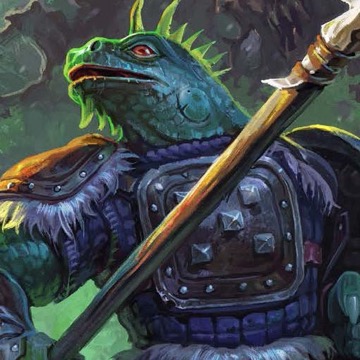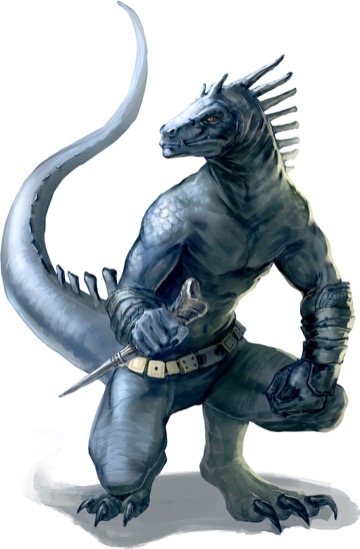Those of you who have been following the Oblivion Oath campaign on Paizo’s Twitch channel are likely already familiar with Zel, the lizardfolk adventurer who has been caught up in strange and frankly creepy events beyond his control. Jason Bulmahn stressed that lizardfolk—or iruxi, as they call themselves—would not be a player ancestry in the Pathfinder 2E Core Rulebook, but us developers have known for a while that they’d be quickly following along on the Core Rulebook’s coattails. In fact, Zel has been using the final lizardfolk ancestry rules for a while, and with the upcoming release of the Lost Omens Character Guide, you’ll soon be able to do the same!
In the case of the Pathfinder developers and designers, this also gives us an opportunity to expand upon lizardfolk in ways we haven’t had the opportunity to do so until now. There have been hints of a more robust lizardfolk culture scattered across multiple Paizo products, but oftentimes, those hints never coalesced into anything tangible for the PCs to encounter during adventures. Most meetings with the iruxi follow the exact same template—an isolated tribe of lizardfolk living in simple, ramshackle huts in the middle of a jungle or swamp.
When outlining the iruxi entry for the Lost Omens Character Guide, I asked for something that was truly primordial. Much like crocodiles or sharks, lizardfolk have been present on Golarion for spans of time that are unfathomable to the human mindset. Iruxi are old enough that some of their treasured ancestors are actually fossils. They had nations that were ancient before the elves even set foot on the planet, and they survived through the destruction of Earthfall not by fleeing or by magic, but by simple virtue of their nature as highly adapted predators. They may not have changed in millions—or even billions—of years, but that’s because they’re so well-evolved for their lifestyle that they haven’t needed to.
(Though if we follow the crocodile and shark metaphors too far, that might imply the existence of titanic lizardfolk that existed in prehistoric times. Eek!)
With the inexorable advance of faster-lived mammalian peoples across the globe, however, the iruxi are finding they cannot keep solely to themselves and their old ways anymore. Lizardfolk have so far preferred to be patient and think things through thoroughly before acting, but the tide is starting to turn, and more iruxi are turning their gaze to collaboration with other civilizations. Like hobgoblins and leshies, lizardfolk are an Uncommon ancestry. They are most welcome in lands such as the Mwangi Expanse, where the iruxi nation of Droon in southern Garund is a well-known fact, or in lawless wilds such as the River Kingdoms or the deserts of the Golden Road. While an iruxi might find acceptance elsewhere, many people react to lizardfolk in the same way that they might respond to finding a large alligator lying on their sofa and wearing their slippers. That is to say, for all you reptile fans out there who are about to claim to be delighted by such a thing, not well.
Lizardfolk get 8 Hit Points from their ancestry, are Medium, and have a speed of 25 feet. A lizardfolk speaks Common and Iruxi, plus any additional languages they might pick up. As apex predators, they get an ability boost to Strength, and their incredible patience in the face of pressure and adversary gets them another ability boost in Wisdom. They also get one free ability boost to put in any score. Much like snakes, sharks, and crocodiles, lizardfolk don’t tend to focus much on knowledge outside of the practical, so they get an ability flaw to Intelligence. Neither lizardfolk nor their unfortunate prey consider this much of a weakness, however—lizardfolk are hard to fool, possess razor sharp claws that grant them an unarmed strike, and have the ability to hold their breath for a long time while they quietly lie in wait.
Many iruxi ancestry feats focus on enhancing their physical prowess, as they learn to adapt their formidable natural abilities to an adventuring lifestyle. Iruxi can gain a powerful tail whip attack, use their affinity for natural terrain to catch foes off balance, and further hone their skills with unarmed combat. They also have a few reptilian tricks up their sleeves, such as the ability granted by the following ancestry feat:
Prerequisites: Tail Whip
SHED TAIL (reaction) FEAT 5 LIZARDFOLK
Trigger: You become grabbed.
Requirements: You have a fully grown tail.
You can shed your tail to escape. You cease being grabbed, then Stride without triggering any reactions from the creature that grabbed you. It takes 1 week for your tail to fully grow back. Until it does, you can’t use your tail unarmed attack, and you take a –2 circumstance penalty on checks to Balance.
Along with suggestions for some common Core Rulebook backgrounds appropriate for lizardfolk, the iruxi ancestry entry also notes lizardfolk culture’s love of astrology. As one of the first societies to master telling time by the stars, astrological divination followed soon after, and has become both a point of pride and a way of life to most iruxi. This love of astronomy has found lizardfolk a few friends in the form of displaced Lirgeni astrologers, and GMs might even consider allowing iruxi PCs to take Lirgeni human astrology feats present in earlier sections of the Lost Omens Character Guide!
Eleanor Ferron
Developer
You're A Lizard, Harry
Friday, September 6, 2019







